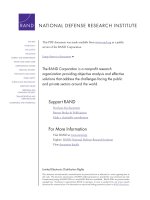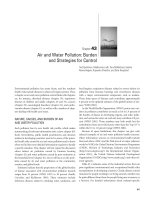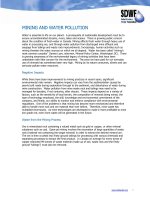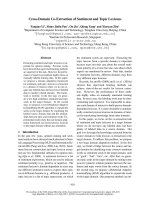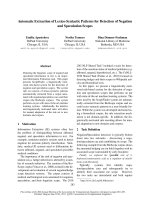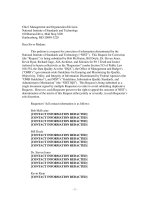NATIONAL DAMAGES OF AIR AND WATER POLLUTION pdf
Bạn đang xem bản rút gọn của tài liệu. Xem và tải ngay bản đầy đủ của tài liệu tại đây (585.23 KB, 132 trang )
NATIONAL DAMAGES OF
AIR AND WATER POLLUTION
By
H. T. Heintz, Jr.
A. Hershaft
G. C. Horak
Contract No. 68-01-2181
Project Officer
Thomas E. Waddell
Office of Research and Development
Prepared for
U.S. ENVIRONMENTAL PROTECTION AGENCY
OFFICE OF HEALTH AND ECOLOGICAL EFFECTS
OFFICE OF RESEARCH AND DEVELOPMENT
WASHINGTON, D.C. 20460
DISCLAIMER
This report has been reviewed by the Office of Research and
Development, U.S. Environmental Protection Agency, and approved
for publication.
Approval does not signify that the contents
necessarily reflect the views and policies of the U.S. Environmental
Protection Agency, nor does mention of trade names or commercial
products constitute endorsement or recommendation for use.
ii
PREFACE
This final report on the "National Damages of Air and Water Pollu-
tion" is submitted under U.S. Environmental Protection Agency Contract
#68-01-2821.
The material in this report is organized under three
chapters presenting the conceptual foundation of estimating pollution
damages, air pollution damages estimates, and water pollution damage
estimates, respectively.
The first chapter contains an appendix describing
a related study of human population at risk to various levels of air
pollutants.
Appendices to subsequent chapters explain in detail the
assumptions and calculations employed in obtaining the damage estimates.
The work presented here was performed by Dr. H. Theodore Heintz,
Jr.,
Senior Economic Consultant, Dr. Alex Hershaft, Director of Environ-
mental Studies, and Mr. Gerald C. Horak, Staff Economist, with the
assistance of Messrs. Erik Jansson and G. Bradford Shea, all of Enviro
Control.
Ms. Anita Calcote was responsible for final typing and produc-
tion of the report.
Review and many valuable comments on the earlier draft were pro-
vided by Dr. A. Myrick Freeman, III
- Bowdoin College, Dr. Thomas D.
Crocker
- University of Wyoming, and Dr. Joe B. Stevens - Oregon State
Univerisity.
The helpful guidance and forbearance of Drs. Fred H. Abel,
Dennis P. Tihansky, and Thomas E. Waddell of the U.S. EPA's Washington
Environmental Research Center are gratefully acknowledged.
iii
ABSTRACT
This report presents updated estimates of the national damages in
1973 of air and water pollution.
Information on pullution damages here-
tofore scattered among numerous sources has been compiled and updated to
reflect "best estimates" of the economic significance of the impacts of
air and water pollution. The conceptual foundations of damage estimates
are discussed.
The source studies for each damage category are surveyed, and
updated best estimates including a range to represent their uncertainty,
are then developed. Best estimates of air pollution damage are devel-
oped for the following categories: human health, $5.7 billion; aesthetics,
$9.7 billion; vegetation, $2.9 billion; and materials, $1.9 billion. The
total best estimate for air pollution damages is $20.2 billion with a
range of $9.5 to $35.4 billion.
A methodology for estimating human popu-
lations at risk to air pollutant levels is described.
Best estimates of water pollution damages are developed for the
following categories: outdoor recreation, $6.5 billion; aesthetics and
ecological impacts, $1.5 billion;
health damages $.6 billion; and pro-
duction losses, $1.7 billion.
The total best estimate for water pollution
damages is $10.1 billion with a range of $4.5 and $18.7 billion.
The caveats qualifying these damage estimates are discussed. Even
so, the study recognizes that tradeoffs are inherent in any decision
making process and a better understanding of those tradeoffs will allow
for improved decision making.
iv
TABLE OF CONTENTS
Page
II.
DAMAGES OF AIR POLLUTION
A.
Overview
1.
2.
Summary of results
Procedures
B.
C.
D.
Damages to Health
1.
2.
Survey of source studies
Damage estimates
Aesthetic Damages
1.
Survey of source studies
2.
Damage estimates
Damages to Vegetation
1.
2.
Survey of source studies
Damage estimates
PREFACE
ABSTRACT
LIST OF FIGURES
LIST OF TABLES
I.
INTRODUCTION
A.
Purpose and Scope
1.
2.
Background
Purpose and scope
B.
Conceptual Foundations
1.
Benefit estimates
2.
Damage functions
3.
4.
Valuation of effects
Aggregation of results
5.
Representation of uncertainties
APPENDIX. HUMAN POPULATION AT RISK TO VARIOUS LEVELS OF
AIR POLLUTANTS
1.
Introduction
2.
Study design
3.
Study performance
4.
Conclusions
iii
iv
viii
viii
I-1
I-1
I-1
I-3
I-5
I-5
I-7
I-11
I-13
I-15
I-19
I-19
I-20
I-23
I-26
II-1
II-1
II-1
II-2
II-5
II-5
II-9
II-12
II-12
II-14
II-16
II-16
II-21
v
TABLE OF CONTENTS
(continued)
Page
II-23
E.
Damages to Materials
II-23
II-25
1.
2.
Survey of source studies
Damage estimates
II-27
F.
More Elusive Damages
APPENDIX.
CALCULATION OF AIR POLLUTION DAMAGES
II-32
1.
2.
Calculation of air pollution damages to health
Calculation of aesthetic damages of air pollution
3.
Calculation of air pollutant damages to vegetation
4.
Calculation of air pollutant damages to materials
II-32
II-37
II-37
II-38
III-1
III. DAMAGES OF WATER POLLUTION
A.
Overview
III-1
1.
2.
Summary of results
Procedures
III-1
III-2
III-4
B.
Damages to Outdoor Recreation
1.
Survey of source studies
2.
Damage estimates
III-4
III-7
III-10
C.
Aesthetic and Ecological Damages
1.
Survey of source studies
2.
Damage estimates
III-10
III-11
III-12
D.
Damages to Health
III-12
III-12
1.
2.
Survey of source studies
Damage estimates
III-14
E.
Production Damages
III-14
III-16
III-18
1.
Nature of production damages
2.
Survey of source studies
3.
Damage estimates
F.
Property Value Damages
III-22
III-22
III-23
1.
Survey of source studies
2.
Damage estimates
vi
TABLE OF CONTENTS
(continued)
Page
APPENDIX.
CALCULATION OF WATER POLLUTION DAMAGES
III-28
1.
Calculations for outdoor recreation damages
from water pollution
III-28
2.
Computations for aesthetic damage of water pollution
III-37
3.
4.
Computations for production damages of water pollution
III-38
Computations for health damages from water pollution
III-45
vii
LIST OF FIGURES
No.
I-1
Hypothetical Damage Function
I-2
Particulate Isopleths for Denver (1973)
I-1
I-2
I-3
I-4
I-5
II-1
II-2
II-3
II-4
II-5
II-6
III-1
III-2
III-3
LIST OF TABLES
Population Characterized by Socioeconomic and Demo-
graphic Factors Exposed to Classes of Air Pollutant
Concentrations
Population Characterized by Socioeconomic and Demo-
graphic Factors Exposed to Classes of Air Pollutant
Concentrations
Population Characterized by Socioeconomic and Demo-
graphic Factors Exposed to Classes of Air Pollutant
Concentrations
Population Characterized by Socioeconomic and Demo-
graphic Factors Exposed to Classes of Air Pollutant
Concentrations
Population Characterized by Socioeconomic and Demo-
graphic Factors Exposed to Classes of Air Pollutant
Concentrations
Estimated National Damages of Air Pollution for 1973
Availability and Reliability of Information on Air
Pollution Damages
Listing of Property Value Studies
Estimated Air Pollution Damage to Vegetation
Materials Damage Estimates
Studies Comparing Vegetation Yields with Seasonal
Ozone Levels
Estimated National Damages of Water Pollution for 1973
Availability and Reliability of Information on Water
Pollution Damages
Potential Annual Economic Damages to Recreational
Users from Water Pollution
viii
Page
I-9
I-25
I-27
I-28
I-29
I-30
I-31
II-1
II-2
II-13
II-21
II-26
II-39
III-1
III-2
III-8
LIST OF TABLES
(continued)
No.
III-4
Estimated National Production Damages Attributed to
Water Pollution, 1973
III-5
Potential Annual Economic Damages to Recreational
Users from Water Pollution
III-6
Estimates of Annual Health Damages from Drinking
Water Quality
Page
III-18
III-29
III-46
ix
I.
INTRODUCTION
This chapter sets the scene for presentation of the actual esti-
mates of national damages of air and water pollution in subsequent chap-
ters.
The topics covered are the purpose and scope of this project and
the conceptual foundations of pollution control benefit analyses.
A.
PURPOSE AND SCOPE
This section presents the purpose and scope of this effort in terms
of its background, purpose,
objectives, scope, and plan of work, as well
as the organization of the report.
1.
Background
Nearly everyone is now satisfied that there exists a causal
relationship between environmental pollution levels and certain
damages suffered by society.
These may take the form of increased
incidence and prevalence of disease,
diminished recreational expe-
rience, decreased property values, reduced crop yields, more fre-
quent maintenance and replacement of exposed materials, and other,
less well-identified losses. This being the case, a reduction in
pollutant levels through implementation of pollution controls
should bring about a corresponding decrease in these damages and
produce a set of benefits equivalent to the difference in damages
with and without the controls.
Legislators, planning officials, and other environmental de-
cision makers are frequently faced with the decision of how much
pollution control to apply, in the light of the associated direct
costs of pollution control and possible secondary economic impacts.
In the past, the rationale for these decisions was rather obvious
and they were frequently made in response to popular sentiment.
However, with the passing of time, the costs became more acutely
felt, especially in the wake of the energy crisis. At the same
time, the beneficical effects of reduced, or stable, pollution
levels were neither obvious, nor easily measured.
Clearly, the
I-1
decision makers needed a more sensitive tool for comparing and
trading off the costs and benefits of various levels and types
of pollution control.
It was this need that spawned renewed interest in environ-
mental benefit/cost analysis, or benefit assessment research. Ad-
mittedly, this is not an exact science, primarily because social
benefits and costs are diffuse and frequently difficult to express
in monetary terms.
Even so, the process of logical and systematic
scrutiny inherent in benefit/cost analysis provides a better in-
sight into the environmental problems, the underlying causes, the
associated effects, and potential solutions.
Consequently, the
process itself can contribute substantially to the ability of de-
cision makers to improve the social welfare through more efficient
allocation of the limited resources of the public treasury.
This potential contribution of benefit/cost analysis was rec-
ognized by the framers of the National Environmental Policy Act
of 1969 (PL 91-190), primarily in Sections 102 and 204. Section
102 calls for the "identification and development of methods and
procedures which will ensure that presently unquantified environ-
mental amenities and values may be given appropriate consideration
in decision making,
along with economic and technical considera-
tions."
Section 204 charges the Council on Environmental Quality
to gather, analyze, and interpret timely and authoritative informa-
tion concerning the conditions and trends in the quality of the
environment.
In recent years, there have been a number of estimates of
benefits of air and water pollution control. Among the most no-
table were the reports on air and water pollution by Waddell (1974)
and Unger et al. (1974), respectively.
Most of these efforts in-
volved minor improvements in the extrapolation and aggregation of
local estimates to the national level as well as inflationary ad-
justments.
There has been little progress in the basic estimates
that form the building blocks of the national estimate.
I-2
In 1974, the U.S. Environmental Protection Agency's Washing-
ton Environmental Research Center was assigned the task of produc-
ing a massive report for the U.S. Congress on the costs and bene-
fits of air and water pollution control (U.S. EPA, 1976). The pre-
sent document is a revised version of Enviro Control's original in-
put to that report. A critical review of the benefits research
program is being published by Enviro Control under separate cover
(Hershaft et al., 1976).
2.
Purpose and Scope
The purpose of this project is to assist public decision ma-
kers by providing some quantitative measure of the national bene-
fits of controlling air and water pollution. This should prove
especially valuable in understanding the nature and sources of
pollution control benefits,
in allocating limited pollution con-
trol resources, and in determining the desirable degree of con-
trol.
The scope of this effort can be characterized in terms of
pollutants, their effects, affected populations, geographic areas,
and time frame.
In the case of the first item, all pollutants
known or suspected of having a significant effect are considered.
The damage categories adopted here for air and water pollution are
as follows:
Air Pollution
Human health
Aesthetic and
recreation
Vegetation
Materials
Water Pollution
Outdoor recreation
Aesthetic and ecological
Human health
Production (municipal, in-
dustrial, and agricultural
supplies; commercial fish-
eries; materials damage)
I-3
The gross national damage estimates in each category are ob-
tained by extrapolating and aggregating results of scattered local
studies.
The extent of disaggregation of individual pollutants
and damage categories provided in the source studies is generally
preserved here.
The additional breakdown of damages by population
classes is possible, but the substantial effort involved is beyond
the means of this study. Finally, the time frame for the entire
effort is the year 1973.
The specific estimates in this report were derived in most
cases by revising previous estimates to reflect improved extrapo-
lation and aggregation techniques and changes in the economic and
demographic conditions.
The principal source for air pollution
control benefit estimates was Economic Damages of Air Pollution
(Waddell, 1973), whereas benefit estimates for water pollution
control were derived in conjunction with the preparation of a pa-
per by Abel, Tihansky, and Walsh (1975). The sources of data
and techniques employed in arriving at specific estimates are de-
scribed in detail in the appendices.
The material in this report is organized under three chapters,
presenting the conceptual foundations of estimating pollution dam-
ages,
air pollution damage estimates, and water pollution damage
estimates, respectively. The first chapter contains an appendix
describing a related study of human population at risk to various
levels of air pollutants. Appendices to subsequent chapters ex-
plain in detail the assumptions and calculations employed in ob-
taining the damage estimates.
I-4
B.
CONCEPTUAL FOUNDATIONS
This section takes up the conceptual foundations of estimating
pollution control damages and benefits. The topics covered include
nature and role of benefit estimates, damage functions, valuation of
effects, aggregation of results, and representation of uncertainties.
Most of this discussion is abstracted from the two publications by
Hershaft et al. listed in the bibliography.
1.
Benefit Estimates
Benefits of controlling air and water pollution arise from
the reduction of damages caused by pollution, or the increase in
available options.
Costs of pollution control are defined here
as the resources expended on pollution control programs leading
to the reduction in damages. The Council on Environmental Qual-
ity refers to damages of pollution as damage and avoidance costs
and to costs of pollution control as abatement and transaction
costs.
Individuals can experience damages in a number of ways which
can be classified as:
Unavoided damages
Avoidance damages
Non-user damages.
Unavoided damages are all those losses of goods and services
which an individual is unable or unwilling to avoid.
These in-
clude damages to health, vegetation, and materials, as well as
aesthetic damages. Avoidance damages, on the other hand, are
those losses incurred in the process of preventing pollution dam-
ages.
Examples are treatment of water supplies, planting of less
susceptible crops, painting of exposed surfaces, and driving far-
ther to find a less polluted recreation site.
I-5
Pollution damages can also accrue to non-users, i.e., people
who have no plans of making direct use of an environmental amenity
but are nevertheless willing to pay for their restoration and main-
tenance because of a variety of values. These have been referred
to as option, vicarious, preservation, and risk aversion values.
In the case of option value, these people are willing to pay for
an option of being able to use the clean environment in the future.
Vicarious, or bequest, benefits are experienced by people who wish
to provide these environmental amenities to others and to future
generations.
Preservation value is associated with the desire to
preserve a unique natural resource. Finally, risk aversion refers
to the willingness of people to pay for decreasing or averting the
risk of a catastrophic or irreversible damage, such as flooding of
arable land or extinction of a biological species.
Estimation of pollution control benefits should ideally fol-
low the steps listed below:
The
Project pollutant emissions on the basis of popula-
tion levels and economic activity for the area and
period under consideration
Estimate reduction of pollutant emissions attribut-
able to implementation of given control policy
Estimate improvements in environmental quality as-
sociated with stipulated reduction of emissions
Estimate increased uses of the environment associ-
ated with improvement in environmental quality
Estimate regional monetary benefits on the basis of
willingness to pay for reduction in adverse effects
and other considerations
Extrapolate and aggregate regional benefit esti-
mates across all regions and time periods of in-
terest to obtain national estimates.
first two steps involve the projection of a suitable eco-
nomic scenario and evaluation of the cost effectiveness of various
administrative and technological pollution control fixes.
The third
I-6
step requires the use of complex models of the diffusion and as-
similation of specific pollutants within their respective media.
The remaining steps rely on the development of damage functions
(measurement of effects) and economic benefit analysis (valuation
of effects). These topics receive closer scrutiny in the pages
that follow.
2.
Damage Functions
A damage function is the quantitative expression of a rela-
tionship between exposure to specific pollutants and the type and
extent of the associated effect on a target population.
Exposure
is typically measured in terms of ambient concentration levels and
their duration and it may be expressed as "dosage" or "dose". The
former is the integral of the function defining the relationship
between time and ambient level to which the subject has been ex-
posed.
Dose, on the other hand, represents that portion of the
dosage that has been instrumental in producing the observed effect
(e.g., the amount of pollutants actually inhaled in the case of
health effects of air pollution).
Dose rate, or the rate at which ambient concentration varies
with time, has a major influence on the nature and severity of the
resultant effect. Long-term exposure to relatively low concentra-
tions of air pollutants may result in manifestations of chronic
disease, characterized by extended duration of development, de-
layed detection,
and long prevalence.
Short-term exposure to high
concentration levels, on the other hand, may produce acute symp-
toms, characterized by quick response and ready detection, as well
as chronic, cumulative, or delayed effects.
The effect can become manifest in a number of ways and can
be expressed in either physical and biological, or economic terms.
If the effect is physical or biological, the resultant relation-
ship is known as a physical or biological damage function, or a
dose-effect function.
In an economic damage function, on the
other hand, the effect is expressed in monetary terms.
Economic
I-7
damage functions can be developed by assigning dollar values to
the effects of a physical or biological damage function, or by
direct correlation of economic damages with ambient pollutant
levels.
The population at risk can consist of one or more human be-
ings, animals, plants,
or material substances. Its characteriza-
tion is crucial to the determination of damage functions for sev-
eral reasons. First, it serves to define the total damages asso-
ciated with a given level of exposure by multiplying the corres-
ponding unit damage (e.g.,
increased mortality) for the specified
population at risk (e.g.,
white males over 65) by the total num-
ber of units within this population. Secondly, it permits inves-
tigators to adjust their results to reflect the influence of var-
ious intrinsic (e.g., age,
race, sex) and extrinsic (e.g., general
health, occupation, income,
and education) variables in assessing
the specific effects of air pollutants (e.g., increased incidence
of lung cancer).
Finally, it can provide useful guidance for al-
locating pollution control resources by identifying areas with
particularly susceptible populations exposed to relatively hazard-
ous levels of pollutants.
A recent characterization of the U.S.
population exposed to different levels of air pollutants is de-
scribed in the appendix.
A representative, S-shaped economic damage function, showing
the marginal benefits corresponding to a given improvement in en-
vironmental quality, is presented in Figure I-1. The lower por-
tion of the curve indicates that, up to a certain exposure value,
known as "threshold level",
no damage has been observed, whereas
the upper portion suggests that there is a saturation level (e.g.,
death of the target population),
beyond which increased pollutant
levels do not produce additional damages. The frequent assumption
about linearity of a damage function is most valid in the middle,
quasi-linear portion where missing data points can be readily in-
terpolated.
I-8
Figure I-1.
Hypothetical Damage Function
The data required to develop physical or biological damage
functions are obtained primarily through epidemiological, field,
clinical, toxicological,
or laboratory investigations.
The first
approach involves the comparative examination of the effects of
pollutants on selected segments of population exposed to different
levels of pollution,
in order to deduce the nature and magnitude
of the likely effect.
Field observations represent a similar ap-
proach to assessment of effects on animals, vegetation, and ma-
terials, and they are characterized by similar analytical tech-
niques and concerns.
Clinical studies are based on hospital ob-
servation of the results of exposure on human subjects.
logical investigations involve deliberate administration
trolled doses of pollutants to animal subjects and observation of
Toxico-
of con-
the resulting effects.
Laboratory studies represent essentially
the same approach for determining effects of pollutants on plants
and materials.
Development of damage functions is beset by a number of ma-
jor problems that may affect substantially the accuracy and reli-
ability of the resulting benefit estimates.
The more important
among these are:
I-9
Collection of reliable ambient quality data
Measurement of exposure
Selection of representative populations
Measurement of effects
Definition of exposure-damage relationship.
Collection of sufficient air and water ambient quality data
requires a very large number of measuring stations and a massive
commitment of measurement and data handling well in excess of the
present level.
This is because one is dealing with numerous point
and non-point sources of pollutants discharging at irregular inter-
vals into fluid media, where these pollutants are subject to various
ill-defined physical forces and chemical interactions. Consequently,
the available data seldom reflect hourly, or even diurnal variations
that may be important.
The exposure index for each pollutant should be selected to
account for both level and duration as well as presence of other
pollutants, or influence of meteorological or hydrological factors.
The populations studied used to be representative of the population
at large in terms of susceptibility to detectable levels of damage.
In the case of health effects, this involves segregation based on
demographic and socioeconomic makeup of the population at risk.
Measurement of the resultant effects is never easy, but it
becomes especially problematic in the case of psychic damages, such
as those associated with health, recreation, aesthetics, option,
and preservation values.
Such damages are not adequately assigned
costs by the market system,
because they are aspects of environmen-
tal use that are neither privately owned nor exchanged through mar-
ket transactions. Thus, estimation of the corresponding benefits
requires development of proxy or surrogate measures.
Finally, damage functions must be frequently plotted through
only a few data points. Even small errors in the location of these
points or in the assumption about the detailed shape of the curve
can lead to major estimation errors.
I-10
3.
Valuation of Effects
The three common methods for estimating marginal benefits asso-
ciated with a given reduction in pollution level are known as:
Alternative cost
Opportunity cost
Willingness to pay.
The alternative cost method is based on assignment of mone-
tary values to effects determined with the aid of a physical or
biological damage function.
This method is employed most fre-
quently, because of its rapid applicability and avoidance of com-
plex economic analysis. However, because there is no provision
for substitution or any other mitigative adjustment by the target
population, the damage estimate may be excessive. Opportunity
cost, on the other hand, is estimated on the basis of the costs
of substitution and other adjustment opportunities open to the
target population. This method presumes that title to the envi-
ronmental good is held by the target population, which is then
entitled to trade it away for a substitute good.
Finally, the willingness to pay method seeks to determine how
much the affected population is willing to pay to avoid a given
environmental degradation.
Here, the title to environmental qual-
ity is presumed to be vested in the perpetrators of environmental
degradation, rather than the target population.
A variation of
this approach, known as the compensation method, assumes that the
title is vested in the target population and attempts to deter-
mine how much compensation an individual would require to accede
to a given loss of environmental quality.
Estimation of benefits on the basis of the individual's will-
ingness to pay entails the intermediate steps of assessing changes
in user behavior associated with anticipated reductions in effect
and of assessing the marginal willingness to pay associated with
these changes.
Changes in individual's behavior reflect the ac-
I-11
perception of these changes. Consequently,
social customs and economic conditions.
tual changes in environmental quality as well as the individual's
they vary
with local
Direct measures of the individual's willingness to pay for
changes in environmental quality can be inferred from individual
responses to such changes by a number of sophisticated, though im-
precise, methods. These are:
Market studies
Travel cost studies
Personal interviews
Delphi method
Legislative and litigation surveys.
Market studies, such as those investigating differences in
property value or income, employ prices or wages as an indication
of the values affected by pollution, and their usefulness has been
demonstrated in a number of cases.
This approach is heavily depen-
dent on the investigator's ability to identify and isolate the many
other factors that affect the value of property, or other indicator
used.
Travel cost studies seek to determine the additional costs
incurred by a user in traveling to a more distant, less polluted
recreation site.
Surveys of public opinion based on personal interviews have
been particularly helpful in understanding how attitudes about pol-
lution are formed and shaped by changes in environmental quality.
The major difficulty with this approach lies in the tendency of re-
spondents to bias their responses in a manner that will advance
their particular point of view. Recent innovations in interview
and data interpretation techniques have attempted to address this
bias.
Surveys of legislative decisions or litigation awards can al-
so provide some insights into a collective assessment of the will-
ingness to pay.
I-12
Inasmuch as benefits are defined as reduction of damages as-
sociated with an improvement in the level of environmental quality,
it becomes very important to specify the environmental quality lev-
els being compared.
The two levels should be compared within the
same time frame, on a "with" vs.
"without" pollution controls basis,
rather than in a "before" vs. "after" setting, to avoid complications
due to inflation, change in relative value of environmental amenities,
and other temporal variations.
The uncontrolled, "without" level is
typically the current or some other value projected on the basis of
expected population growth and economic development. The controlled,
or "with",
levels can be selected from among the following alterna-
tives:
Zero ambient concentration (highly unrealistic: would
involve cleanup of natural sources)
Zero man-made emissions (again, very unrealistic: would
involve extreme control measures)
Ambient levels corresponding to the respective air qual-
ity standards
Threshold levels (very controversial)
Projected levels (on the basis of postulated reduction
in emissions).
4.
Aggregation of Results
Most benefit estimation studies address a specific geographic
location, group of pollutants, population at risk, and time period.
Extension of these results to the national level and some future
time frame requires the extrapolation and aggregation of the re-
gional estimates and projection of a number of variables, including
ambient levels, populations at risk, personal incomes, and costs of
damages.
Aggregation of benefit estimates entails a tradeoff of detailed
information about form and structure in return for treatability and
ease of comprehension. Attempts to apply aggregated national esti-
mates to local pollution control decisions can introduce substantial
I-13
errors, because the information lost in the aggregation process
frequently cannot be recovered.
In fact, it may be possible to
develop national estimates directly, rather than by aggregation
of local studies.
Definition of the benefit categories for which the data are
collected are often dictated by availability of sources and analy-
tical expediency, rather than the needs for a uniform, self-con-
sistent framework. Consequently, different studies evaluate dam-
ages that are not necessarily additive, or even comparable, and
careful interpretive techniques must be applied to these results
to prevent gross overlaps or omissions of individual estimates.
Moreover, in aggregating such fractional results, it is not possi-
ble to reflect the potential impacts of changes in individual com-
ponents on one another, nor the impact of the general adjustments
of the economy and the resulting reduction in damages.
Overlaps and gaps between categories of benefits may arise
when two types of effects (e.g., health effects and property val-
ues, in the case of air pollution, and recreation benefits and
property values, in the case of water pollution) are estimated by
different methods which may count the same benefit component twice
or fail to capture certain other components.
It is important,
therefore, to attempt removal of the excess count and to input a
value for the missing component.
Another problem is the incon-
sistency in quality of estimates for different benefits categories.
Finally, in aggregating over several variables (e.g., pollutants,
populations at risk, effects, geographic areas, time periods), it
is important to specify the order in which the variables are being
aggregated.
If the benefits of interest accrue over a number of years,
then it may be useful to compute the present value of the total
stream of benefits with the aid of an appropriate discount rate
and time horizon. This approach becomes less effective when the
projected effects extend over a very long time period that spans
several generations, because of the large reduction factor. For
I-14
example, using a discount rate of 5 percent, the current benefit
of an effect occurring 200 years hence is reduced by a factor of
6 x
10-J.
In such cases, our moral obligation to the future popu-
lation needs to be considered alongside sheer economic efficiency.
5.
Representation of Uncertainties
Uncertainties about benefit estimates arise from errors in
the four steps of the estimation process:
Aggregation
Valuation
Specification
Measurement.
Errors of aggregation are associated with attempts to extra-
polate national values from regional estimates and future values
from current or past estimates. They arise from overlaps and gaps
between benefit categories as well as from temporal variability of
user behavior and market conditions. Errors of valuation are due
to the difficulty of assigning monetary values to certain physical,
biological,
aesthetic, or non-user benefits, as well as to biases
inherent in direct valuation.
Errors of specification include any type of error in specify-
ing the functional form of the relationship under study or in ac-
counting for important variables.
A particularly common and grave
error of specification is committed in attempting to extrapolate a
complete functional relationship from a few data points that are
the curve. Even
overall shape
which por-
barely adequate to characterize a small portion of
if one were willing to make an assumption about the
of the function, there is frequently no way of knowing
tion is represented by these data points.
Errors of measurement may be attributed to the
tors involved in the benefit estimation process:
following fac-
I-15
Disparities in location of monitoring stations and
subjects
Errors of pollutant sampling and analysis
Uncertainties in determining exposure
Inadequate characterization of population at risk
Uncertainties in determining effect
Impact of covariates.
If the errors of measurement of the independent variables are
relatively small, occur at random,
and follow a normal, or Gaussian
distribution about the mean value of each variable, then the total
error of all the independent variables can be computed by standard
probabilistic techniques.
However, this is seldom the case, be-
cause measurement of such independent variables as pollutant level,
meteorological conditions,
and socioeconomic characteristics is sub-
ject to errors that are both large and biased. The advantages of
the probabilistic approach include an opportunity to incorporate
more information in the reported results and the assignment of a
probability to the various outcomes. Envelopes characterizing er-
rors and uncertainties of benefit estimates can be also obtained by
more practical means, including:
Replicating a specific study using new data or
methods
Manipulating values of the more important vari-
ables
Combining results of several studies
Applying "best"
and "worst" case assumptions.
Replication and data manipulation are essentially empirical
techniques for determining the errors and corresponding confidence
bands.
Combining the results of several studies is a rare and un-
certain opportunity, in light of the great variety of conditions
and populations that characterize the different efforts.
Applica-
tion of "best" and "worst" case assumptions is more an argumenta-
I-16

